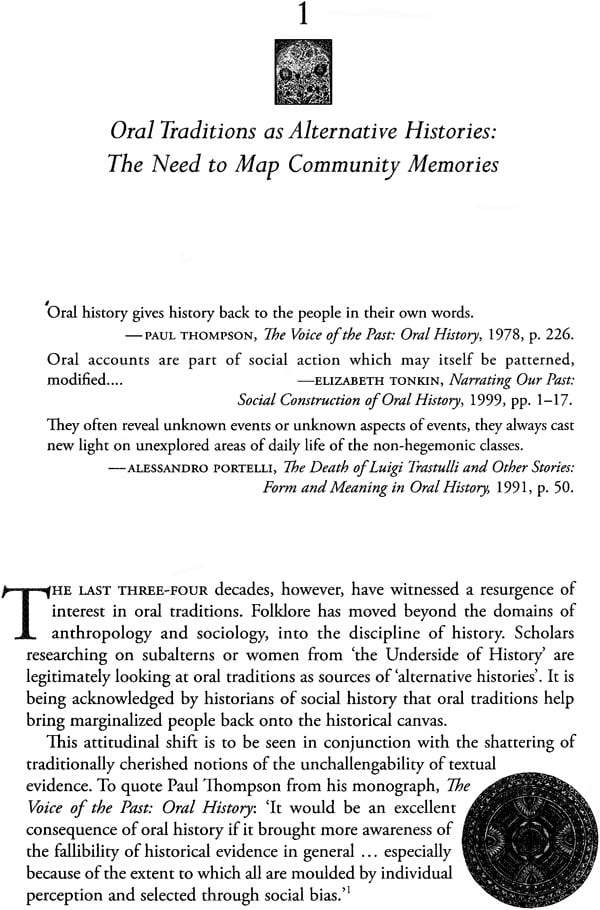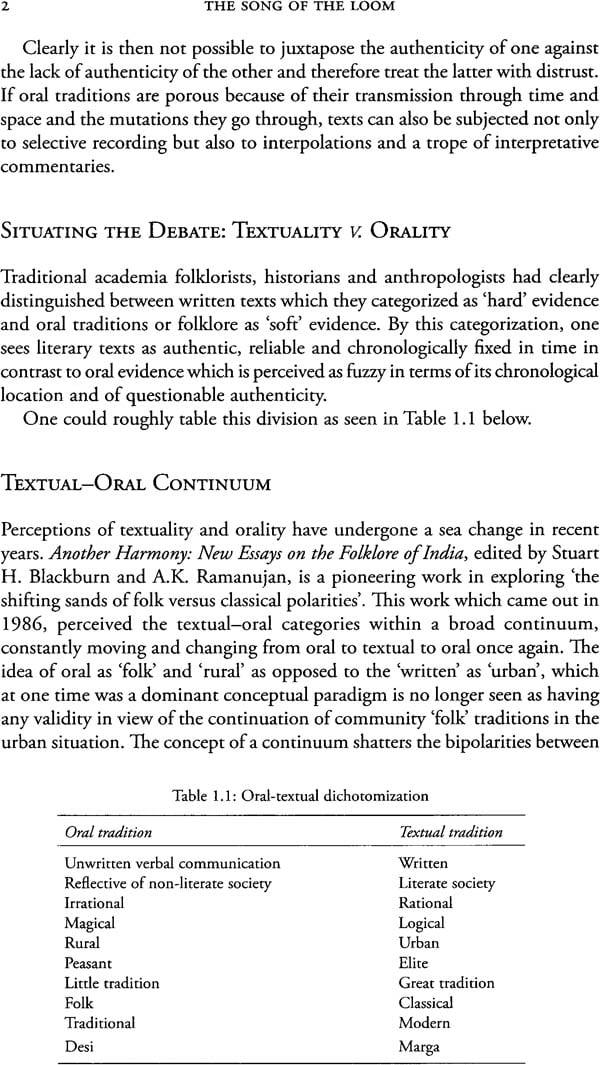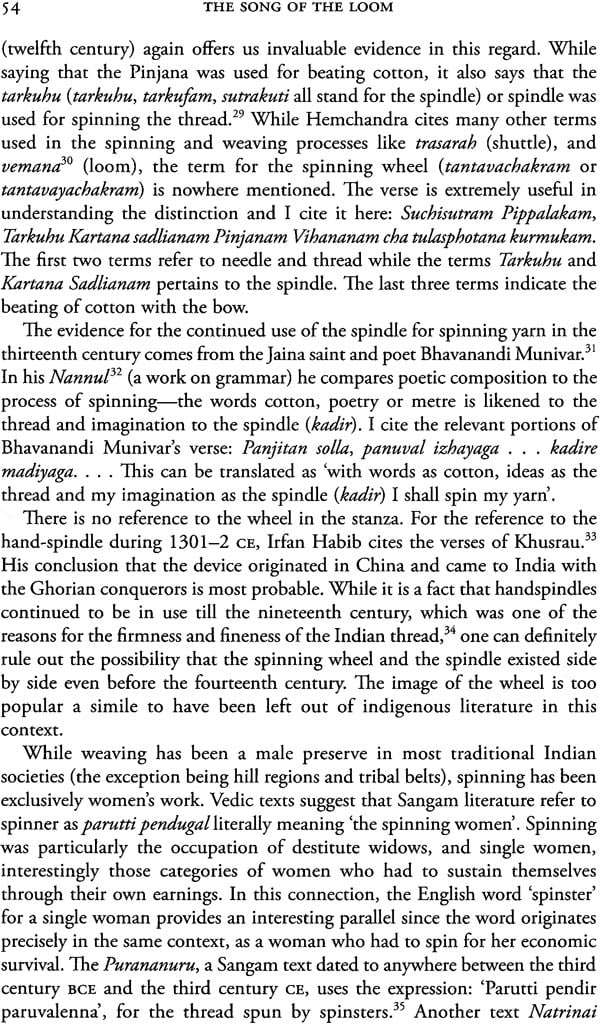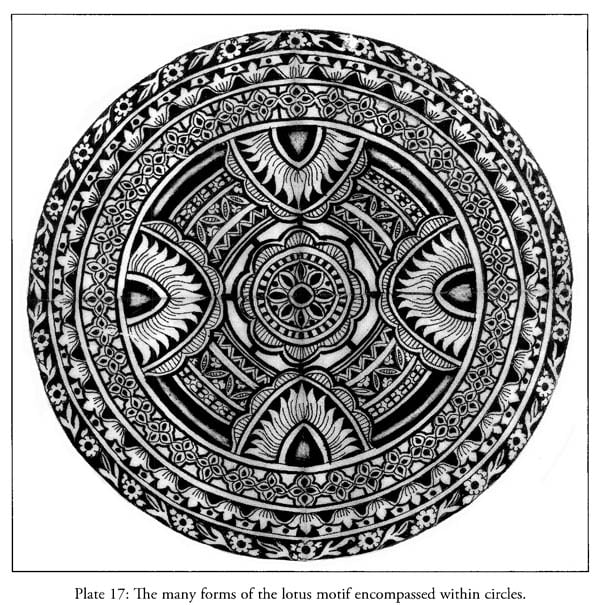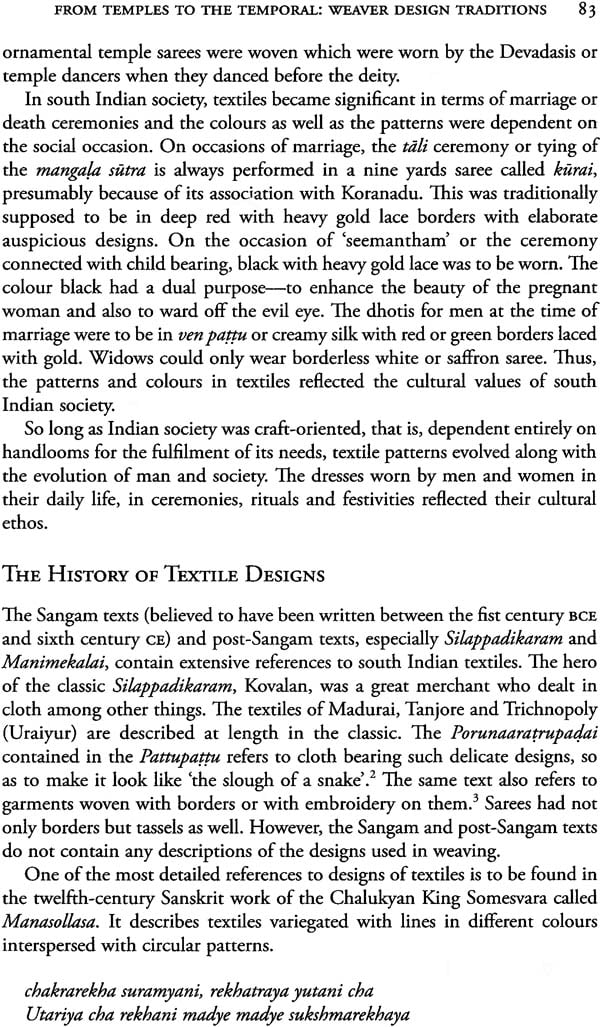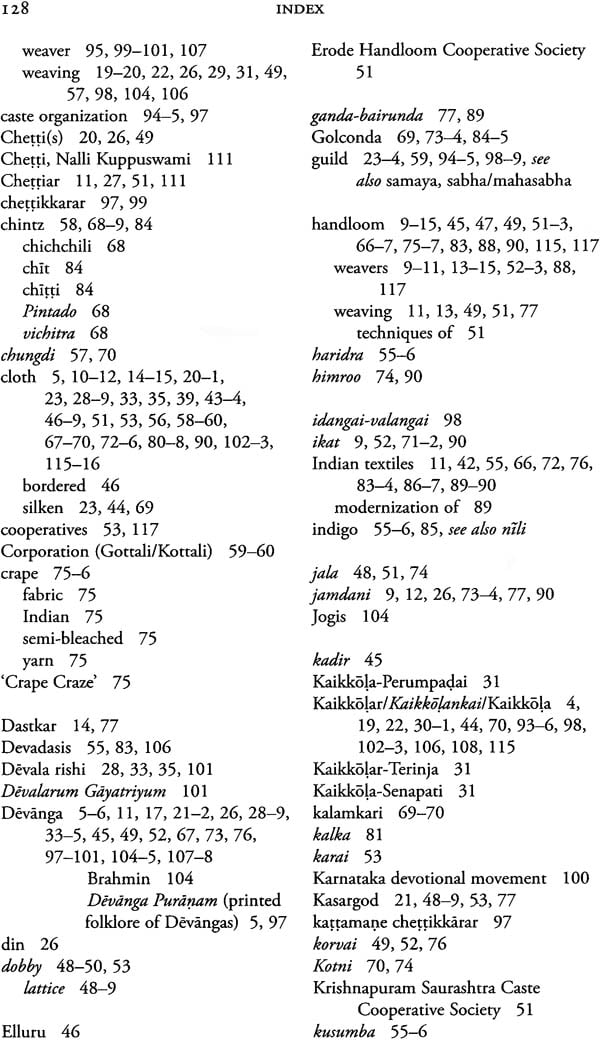
The Song of The Loom (Weaver Folk Traditions in South India)
Book Specification
| Item Code: | NAL979 |
| Author: | Vijaya Ramaswamy |
| Publisher: | Primus Books, Delhi |
| Language: | English |
| Edition: | 2013 |
| ISBN: | 9789380607467 |
| Pages: | 182 (14 B/W and 19 Color Illustrations) |
| Cover: | Hardcover |
| Other Details | 9.5 inch X 6.5 inch |
| Weight | 320 gm |
Book Description
The Song of the Loom tells the story of the hoary tradition of textile weaving in southern India from the perspective of the weavers. It is, hence a narrative from below. Mediated through the author’s interaction with weaving communities for over decades. The author stayed which weavers, participated in their cultural and religious festivals and listened to their many songs, which related to all facets of their lives-their struggles on the loom, their despair with the younger generation which is forsaking tradition way of life and their desperate clinging o their traditions and their memories. The Song of the Loom also records for posterity the loom songs which may soon be lost forever.
This book, however, goes beyond a retelling of folk narrative and the recording of loom of folk narratives and the recording of loom songs. It also about the nitty-gritty of the survival of a leisurely craft which is struggling to stay afloat at a time when speed driven technology is the prime mover in the major commercial domain of textiles and salability and competitive pricing become the decisive factors. The book therefore has chapters on culturally embedded traditional designs, traditional technology versus advancing technology mediated by the notion of ‘appropriate’ technology.
While a plethora of books on the history of Indian textiles have appeared in recent years, the majority of such books, given their great value for academia, are nevertheless ‘histories from above’ based laegely on archival sources. The present book is different in that its narrative is based on interactions with weaving communities. The author has endeavoured to connect the connect the concerns of the weavers with the role of NGOs and government established weaver service centres. This book should therefore provide a valuable feedback to the votaries of the handloom industry.
Vijaya Ramaswaramy is Professor at the Centre for Historical Studies. Jawaharlal Nehru University. New Delhi, and teaches economic history and history of religion in ancient India. Her doctoral thesis is on the ‘History of the Weaving Communities of South India’, and she gives occasional lectures on folklore. Professor Ramaswamy’s publications include Divinity and Deviance Indian Women (2003): Textiles and Weavers in Medieval South India (2006): Historical Dictionary of the Tamils (2007): Walking Naked: Women, Society, Spirituality in South India (2007): Biography as History-India Perspectives (2009): and A to Z of the Tamils (2010).
Walking Through The long and narrow streets of the ‘weaving villages’ of south India, as I did trough Rasipuram in Salem district, Tamil Nadu, one falls under the spell of the rhythmic movement of the shuttles as looms produce the ‘tak-tak’ sound. This is the song of the loom that has been reverberating in Indian craft culture for almost 2,000 years. Superior technology and globalization, in tandem with governmental policies, now threaten to silence these looms forever.
The year 1984 was proclaimed ‘The year of the Handloom’. A number of projects were initiated to preserve and strength the glorious Indian handloom heritage. Pupul Jayakar, who played a leads role in the collection of handlooms and handicrafts, suggested that I should study the folk traditions among the weavers. Since I have received doctorate for my work on the history of handlooms. Therefore I welcomed the idea of research on ‘Weaver Folk Tradition is South India’. This project had the active encouragement of Dr. Jyotindra Jain, the Senior Director of The Crafts Museum, Delhi.
For the past two decades, since the initiation of the project in 1985, I have travelled widely in south India, gathering data on weaver folk traditions. It was sad to perceive that the tradition of loom songs was also extinct except in some parts of Salem, Erode, etc., for these days almost all weavers weave to film music.
The Indian textile industry has a continuing history over 2,000 years old, dating back to the pre-Christian Era. Weaving communities of south India, such as the Senguntar (Kaikkolar), Saliyar and the Devanger, can boasf of a hoary tradition, with their ancestors playing a prominent role in the economic and cultural life of south India during the great temple-building era of the Pallavas and the Cholas. In today’s age of rapidly changing lifestyles and technology explosion, the continuance of the traditional weaving communities in the handloom industry, is a remarkable feature of the south Indian cultural fabric.
Continuance of weaving communities does not mean that the process of survival has been smooth. The Damocles’ sword remains suspended over the handloom weavers, many live constantly on the poverty line. In 1986, in Gugai area of Salem district, in an ancient cotton textile centre I asked a weaver about the condition of the handloom industry in his area and he said: ‘It is the grave pit, not the loom pit’. Coarse carpet weaving on pit-looms still goes on in this area. My presence there was due to an official assignment by the Handloom Board (then under the Ministry of Commerce), to do a project on ‘Weaver Folk Traditions in South India’, a project that was commenced in 1985 and completed in 1988. I revisited these areas in the next two decades.
In the course of my interview with the weavers in Tiruhirapalli, Salem, Thanjavur and Madurai districts, I was startled to find that that they expected me to act as a medium of communication between them and the ‘Sarkar’ at Delsi. They expressed fears about the New Textile Policy’ (framed in 1985), especially the onslaught of the powerlooms on the handloom sector and some of them complained about political interference. Another pertinent appeal which was, however, not given in a written form was made by the Svakula Sale weavers of Bangalore. They held that it was not only simplistic but incorrect to divide textiles merely into handlooms or powerlooms. This division ignored the intermediate category of the small-time entrepreneur who has four or five mechanized looms and is not be confused with large-scale capitalist owners of powerlooms.
Some of them complained about political corruption and the malfunctioning of some cooperatives. The caste sanghas, which presented the community organizations of the weaves, presented petitions they had drafted to the Handloom Board. I took these petitions back to the office of the Development Commissioner of Handloom in New Delhi along with the folk traditions and loom songs that I had been asked to collect. I was told that my job was to collect folk traditions and not listen to the weavers’ petitions. However, a group of Devanga weavers in the Salem area presented a brief petitions to me in Tamil and I promised them that I would at least put them on record. Since this petition would not fit anywhere in the text of the project, I felt it would be appropriate to put it as an appendix in this book, We are now in the year 2012. My report on ‘Folk Traditions’ (in ewhich I had willy-nilly included some of the petitions) lies among other unpublished reports in the Ministry of Textiles. However, I have continued to go back to the weaver, particularly in Salem, which is my ‘maternal’ hometown. Some of these recent researches were presented by me at the special panel on handlooms in the Congress of Traditional Science & Technologies organized by the PPST (Peoples’ Popular Science & Technology) at Chennai in 1996. In the workshop held with weavers and textile manufacturers it became clear that large-scale cloth manufacturers and merchants (especially those dealing in silks) were prospering while subsistence weavers were being pushed below the poverty line. I was told by a weaver from Erode-‘Kadar kadarudu’, a pun on the word ‘Kadar’ which is the Tamil word for khadi. While word ‘kadar’ represents home-mad cloth, ‘kadaral; in Tamil means lamentation. In other words, the weaver was trying to tell me that handlooms were in its death throes.
This book however, does not profess to deal with such issues which are the concern of administrators rather than academicians. Nevertheless in the process of describing folk traditions, I have highlighted the plight of the handloom weavers, not so much the specialist who today managed to find a market (however narrow) among the elite, but the very ordinary weaver who still feeds himself and his family on starvation wages. If the handloom weaver has continued to survive today, it is perhaps because, as Alfred Chatterton, the British civil servant said at the turn of the century, he has learn to live on less and less.
It is hoped that this present study of weaver folk traditions in south India will make a positive contribution not only towards the revival of Indian textile traditions but also to the rehabilitation of the handloom weavers. If the handloom weaver it to regain the rightful place which he occupied at one time in Indian society and economy, it is not sufficient that handlooms should become fashion-ware, exclusive, expensive and within the reach only of the elite. They should be able to hold their own in the competitive market and one again become popular-ware.
The manuscript which was originally in the form of a project report had gone beyond the bounds of official reporting and turned out to be a close encounter with the folk memories of south Indian weaers. While the first lot of interviews with weaving communities took place in 1986, in the subsequent years I kept going back to the weavers to track to track changes in their condition, ideas and organization. Another cluster of interactions with the weavers took place in 1996 when the Association for Popularization of Traditional Science and Technology invited me to initiate and lead an interactive session with the weavers. These however, were not in a formal interview format.
I sincerely hope that this book on weaver folk traditions will find a wider readership of people interested both is based on long periods of fieldwork, participant observation of social and ritual traditions and intensive interactions with weaving communities, especially their womenfolk whom I find to be strong carriers of oral tradition. The study will be of interest to anthropologists, sociologist and folklorists, as well as socially active non-governmental organizations (NGOS) and governmental organizations involved in the recovery and preservation of weaving tradition, both in terms of technology and design techniques as well as weaver community vision.
Research and Fieldwork for The Song of the Loom began over a decade ago, in a manner similar to my three-decade long research on weaving and weavers.
I began, almost by default as it were, with Salem, as ancient weaving centre, as my grandmother lived there. Though curious about my many trieps to Chevvapert, Gugai Rasipuram (Salem), Bhawani and Erode, she was, however, non-interfering unlike many other matriarchs of patriarchal Brahmin households in this early 1970s.
At Rasipuram, as I walked down its long street literally called ‘Peruvidi’. I heard the ‘tak-tak’ of the loom from every house. Its rhythm was so compelling that I took out my little tape and records the music of the looms. My quest took me to the home of Kavignar N. Kandasarmy. He was squatting on the floor reading a book with his spectacles perched on his nose. I was curious to see this weaver scholar to whom I had been directed as a mine of weaver folklore in general and Senguntar songs in particular. In the course of the next seven years I was to spend many hours in his company, learning not just weaver folklore but also about the participation of the Tamils in the freedom struggle. Salem was the home of C.R, Rajagopalachari and the breeding ground for many unknown patriots, both men and women, among whom were also my aunts as was Kavignar N. Kandasamy who had gone to prison in response to Gandhiji’s call. Kandasamy died towards the close of the 1970s, an unsung hero who never received his pension as a freedom fighter but lived his life, in poverty. He taught me to hear and love the many songs of the loom and hence it is dedicated.
Outside Salem, conducting fieldwork in other weaving regions was neither so secure nor so comfortable. I covered the weaving villages and towns of the Thanjavur and Tiruchirapalli regions with Rendakattalai in the vicinity of Kumbakonam as my base and subseqyuently Jambukesvaram from where the ancient weaving centre of Uraiyur. Uraiyur was the argaritic of the Romans. In the 1970s, conducting fielsdwork as a young woman, was fraught with embarrassing and at times difficult situations. In the subsequent decades things began to change, albeit s slowly. A young weaver undertook to accompany me through the weaving areas of Tirunagesvram, Mayiladuturai, Bhuvanagiri, etc. At Rendakattalai I stayed in the house of an aged Brahmin landlord (who no longer owned lands) with household steeped in genteel poverty. Little did I realize what aburden the feeding of an additional mouth would have meant but the question of offering him any monetary compensation was not to be thought of and would have been considered an insult. I would bathe by the well at dawn and carch the one only bus to the big town, i.e. Kumbakonam at 6 a.m. I would return in the last bus between 9 and 10 at night. At Kumbakoonam I would be joined by the weaver and we would begin our visits to the weavers, weavers’ cooperatives and sometimes the weavers’ sanghas or caste organizations. I was passionate about my and being city-bred, perhaps too informal with my companion. I never realized that out cultural coding was very different till he chose the family room for our lunch. Nwardly furious, I also realized that given a social milieu where woman rarely interacted with men other than family member, a working woman like me could be misunderstood.
At Rendkattalai, I was the recipient of the Brahminical perception of the ‘working woman’. The old man was unfailingly polite to me and his sons distant, but courteous. I was most intrigued by Gayathri, his seventeen year-old granddaughter. She bathed at dawn, said her prayers several time a day and hardly ever stepped out of the house. I never saw her in anything but worn our cotton sarees. I would talk to Gayathri of Delhi, my family and work while she listened starry-eyed. One day I casually asked her: ‘Gayathri, don’t’t you want to know how sarees you wear daily are woven? If you come with me, I can show you how weavers weaver weave on their looms. ‘Gayathri was very keen but afraid to ask her grandfather. I went to the old man and suggested that since Gayathri stayed at home all day, I could take her out with me. The old man became very silent and said eventually: ‘She is not a girl like you. She will not cross the boundaries of modesty.’ I was shocked to hear these words. It was only then I knew that he thought of me as both immodest and immoral because I moved freely in the company of weavers. I was young in those days and I cried myself to sleep. I left Rendakattalai the next day without any bitterness but with much sadness. Many years later, I met the old man once again, this time in the ICU of a hospital in Kumbakonam. He recognized me and I held those thin hands with much gratitude. I believe the family sold the house after his death.
A detailed narration of ten years of fieldwork may become tedious but for me it was a journey into the world of the weaver communities. With the Devanga weavers, I celebrated their festival honour of Chandesvari Amman when the historic the historic migration of the Kannada Devabgas into the Kongu region region is commemorated by making a trek from Gugai and Ammapettai to Hosakottai (alittle beyond Namakkal on the Maduri Road). Like any ‘anthropologist’ I took extensive notes and pictures but in the process I also learn Kannada which I now speak with a certain degree of fluency.
My most amusing experience during fieldwork happened in Kanchipuram> Under a hot May sun I walked through the homes of the Saliya and Kaikkola weavers, interviewing them and photographing their looms which varied from pitlooms to horizontal looms, the adai and jala. By noon I was tired and famished, and yet, I was not offered even a glass of water by my kindly hosts. Out of sheer desperation, I finally asked the lady of the house if the house if I could have would be willing to accept water from their hands. Did I wear my caste on my sleeve and why would I not accept their food and drink? The delighted family fed me with sweets, savories and sherbet. It was much late that a man at the weaver service centre explained to me about caste differences in the interior villages and the fact that my speech could betray my caste. I was equally puzzled and deeply hurt when in the 1980s I was ridiculed as a ‘pappati’ which apparently is a pejorative for a Brahmin woman. Society in Tamil Nadu is hopefully moving out of both kinds of typecasting (pun intended!).
My work took me to Uduppi in Karnataka and the areas in which produces some fine cotton. At Uduppi, a quaint temple-town, I came across what I considered and still consider one of the best and most transparent weavers’ cooperative societies, In Andhra Pradesh I travelled in the weaving village of Pchampalli, kayyalaguda and Puttapakka, discovering not only the well known patolas, both single and double ikats but also the comparatively unknown telia, made from yarn soaked in gingili oil for a period of thirteen to sixteen days before it is tie-dyed. This interesting textile was born during the period of the Deccani Sultanates and was oriented towards the WEST Asian markets since it was the telia weaving villages I was following the footsteps of Kamaladevi Chattopadhyaya who had been instrumental in reviving the telia in post-independence India. It was in Puttapakka tthat I visited a temple dedicated to Bhavanadi Rishi, the patron saint of the Telugu Sale. The offering was an unusual one, consisting of peppermints.
| List of Illustrations | ix | |
| Preface | xi | |
| Acknowledgements | xv | |
| Introduction: Gathering The Threads Editorial Method | xvii | |
| Editorial Method | xxi | |
| 1 | Oral Traditions as Alternative Histories: The Need to Map Community Memories | 1 |
| 2 | Situating Handloom Weaving and Weaver Community Traditions | 9 |
| 3 | The Traditional Weaving Castes of South India and the Entrants | 19 |
| 4 | Origin Myths Among the Weaver Castes | 28 |
| 5 | Technological Traditions in the Weaving Industry | 42 |
| 6 | Many Splendoured Weaves: Weaving traditions | 66 |
| 7 | From Temples to the Temporal: weaver Design Traditions | 80 |
| 8 | Weaver Social Traditions | 92 |
| Concluding Strands | 111 | |
| Appendices | 113 | |
| Appendix I: | Proverbs on Weavers and Weaving Work | 115 |
| Appendix II: | Appeal presented by the Manurkala Devanga Wravers of Gugai, Salem on 26 April 1986 | 117 |
| Select Bibliography | 119 | |
| Index | 127 |
